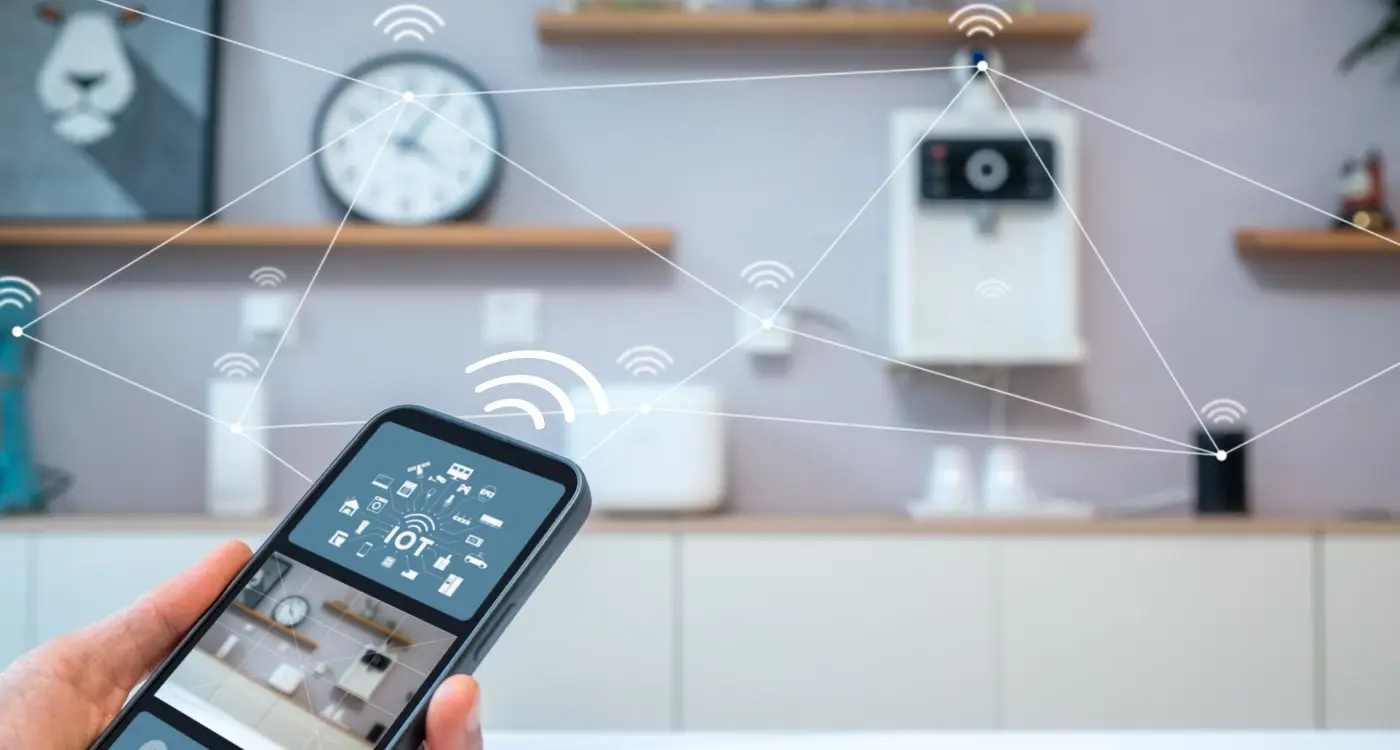How Do You Build Secure Communication Between IoT and Mobile?
The Internet of Things has changed how we interact with technology, connecting everything from smart thermostats to industrial sensors through our mobile devices. But here's what most people don't realise—every single connection between your phone and an IoT device creates a potential entry point for hackers. I've spent years working on mobile applications that communicate with all sorts of connected devices, and the security challenges never get easier; they just get more sophisticated.
When your mobile app talks to a smart doorbell or fitness tracker, data travels across multiple networks and through various protocols. Each step of this journey needs protection. Without proper IoT communication security measures, sensitive information like your location, usage patterns, or even personal conversations can be intercepted. The stakes are particularly high for businesses—imagine if someone gained access to industrial IoT sensors or medical devices through a poorly secured mobile connection.
Security isn't something you bolt on at the end; it needs to be baked into every layer of communication between mobile apps and IoT devices
This guide will walk you through building robust secure IoT protocols and implementing proper device connectivity measures. We'll cover everything from basic authentication to advanced encryption methods, giving you the knowledge to protect both your users and your business from increasingly sophisticated threats targeting mobile IoT connections.
Understanding IoT Communication Basics
Internet of Things devices talk to mobile apps constantly—your smartwatch sends heart rate data, your thermostat receives temperature commands, and your security camera streams video footage. But how does this communication actually work? It's simpler than you might think, though getting it right requires understanding the fundamental building blocks of IoT development.
At its core, IoT communication involves three main components: the device itself, a network connection, and the receiving application. The device collects data through sensors or accepts commands through actuators. The network—whether Wi-Fi, Bluetooth, cellular, or something more specialised like Zigbee—carries the messages back and forth. The mobile app processes this information and presents it to users in a meaningful way.
Common Communication Patterns
Most IoT systems follow predictable patterns for exchanging information:
- Request-response: The app asks for data, the device responds
- Publish-subscribe: Devices broadcast updates when changes occur
- Push notifications: Devices alert apps about important events
- Streaming: Continuous data flow for real-time monitoring
The trick is choosing the right pattern for your specific use case. A smoke detector needs immediate alerts, whilst a soil moisture sensor might only report changes once daily. Understanding these basics sets the foundation for building secure, reliable connections between your IoT devices and mobile applications.
Common Security Vulnerabilities
When building IoT communication security between devices and mobile apps, there are several weak spots that hackers love to target. I've seen too many projects fall victim to these vulnerabilities—and trust me, it's not pretty when your users' data gets compromised.
The biggest problem is weak passwords and default credentials. Many IoT devices ship with simple passwords like "admin123" or "password"—and people rarely change them. Hackers know this and can easily break in. Another major issue is unencrypted data transmission; when information travels between your IoT device and mobile app without proper encryption, anyone listening can intercept it.
Device-Level Vulnerabilities
Insecure firmware updates represent another serious threat. If your device connectivity doesn't verify updates properly, malicious code can be installed instead of legitimate software. Poor session management is equally dangerous—if sessions don't expire or tokens aren't properly validated, unauthorised users can maintain access long after they should be locked out.
Network and Protocol Weaknesses
Secure IoT protocols aren't always implemented correctly. Using outdated versions or misconfiguring settings creates gaps that attackers exploit. Mobile IoT connection points are particularly vulnerable when proper authentication isn't enforced—devices might connect to rogue networks or accept unauthorised commands.
Always change default passwords immediately and implement automatic session timeouts of no more than 30 minutes for sensitive IoT applications.
Authentication and Device Identity
Getting authentication right between IoT devices and mobile apps can feel like solving a puzzle—but it's one of the most important pieces of the security picture. Every device needs to prove who it is before it can start talking to your mobile app, just like showing your ID card before entering a building.
The tricky bit with IoT devices is that they're not like smartphones or computers. Many have limited processing power and memory, which means traditional authentication methods might not work. You can't exactly ask a temperature sensor to remember a complex password!
Device Certificate Management
Digital certificates work brilliantly for IoT authentication because each device gets its own unique certificate—think of it as a digital fingerprint. The mobile app can check this certificate to make sure it's talking to the right device and not some impostor trying to sneak into your network.
Token-Based Authentication
Tokens offer another solid approach, particularly for devices that connect intermittently. Here's how different token types stack up:
- JWT tokens: Great for carrying device information but can become large
- OAuth tokens: Perfect for third-party device integrations
- Custom tokens: Lightweight options for resource-constrained devices
- Refresh tokens: Allow devices to stay authenticated without constant re-verification
The key is matching your authentication method to your device capabilities whilst maintaining strong security. A smart thermostat might handle certificates easily, but wearable devices like fitness trackers might need something more lightweight.
Data Encryption Methods
When you're building secure IoT communication systems, data encryption is your strongest defence against prying eyes. Think of encryption as scrambling your messages so thoroughly that only the intended recipient can unscramble them—even if someone intercepts the data along the way, they'll just see meaningless gibberish.
For mobile IoT connection security, you'll typically use two main encryption approaches. Symmetric encryption uses the same key for both scrambling and unscrambling data; it's fast and efficient, making it perfect for real-time IoT applications where speed matters. AES (Advanced Encryption Standard) is the gold standard here—it's what banks and governments trust with their most sensitive business information.
Choosing the Right Encryption Level
Asymmetric encryption, on the other hand, uses different keys for encryption and decryption. It's slower but more secure for initial handshakes between your mobile app and IoT devices. RSA encryption is the most common choice, though newer elliptic curve methods are gaining popularity because they offer the same security with smaller key sizes.
The weakest link in any encryption system isn't usually the mathematics—it's how humans implement and manage the keys
For most secure IoT protocols, you'll want AES-256 for ongoing communication and RSA-2048 or higher for key exchanges. The numbers refer to key length—bigger generally means more secure, but also slower processing. Your choice depends on balancing security needs with device capabilities and battery life.
Secure Communication Protocols
When your IoT devices need to talk to mobile apps, they can't just chat like friends over a cup of tea—they need proper security protocols. Think of these as the rules that keep conversations private and safe from unwanted listeners.
The most popular protocol you'll encounter is MQTT (Message Queuing Telemetry Transport). It's lightweight, which means it won't drain your device's battery, and it works brilliantly for sending small bits of data back and forth. MQTT uses something called TLS encryption to keep messages secure—basically scrambling them so only the right devices can understand what's being said.
Popular Protocol Options
- MQTT with TLS - Perfect for lightweight messaging between devices
- CoAP (Constrained Application Protocol) - Great for devices with limited power
- HTTPS - The web standard that works well for mobile-to-device communication
- WebSocket Secure (WSS) - Ideal when you need real-time updates
CoAP is another solid choice, especially if your IoT devices are running on battery power. It's designed for constrained devices but still maintains strong security through DTLS (Datagram Transport Layer Security).
The key is matching the protocol to your specific needs—real-time data, battery life, and security requirements all play a part in making the right choice for your project.
Network Security Strategies
When you're building secure communication between IoT devices and mobile apps, your network layer becomes the battlefield where most attacks happen. I've watched countless projects fall apart because teams focused on encrypting data but completely ignored how that data travels through the network—it's like locking your front door but leaving all the windows wide open.
Network segmentation sits at the heart of good IoT communication security. You want to create separate network zones for your IoT devices, keeping them isolated from your main business network. Think of it as creating different neighbourhoods within your network; if something goes wrong in one area, it won't spread everywhere else.
Core Network Protection Methods
VPNs work brilliantly for mobile IoT connection scenarios, creating encrypted tunnels between your mobile app and IoT infrastructure. But here's what many people miss—you need different VPN strategies depending on whether you're dealing with lightweight sensors or more powerful gateway devices.
- Use network firewalls with deep packet inspection capabilities
- Implement intrusion detection systems that understand IoT traffic patterns
- Set up network monitoring to track unusual device connectivity behaviour
- Deploy honeypots to catch attackers before they reach real devices
- Configure rate limiting to prevent DDoS attacks on your IoT endpoints
Always use certificate pinning in your mobile apps when connecting to IoT networks—this prevents man-in-the-middle attacks even if someone compromises your network certificates.
The biggest mistake I see teams make is treating all network traffic the same way. Your secure IoT protocols need different protection strategies than regular web traffic, and your network security should include proper API protection measures that reflect that reality.
Testing and Monitoring Security
Right, so you've built what you think is a rock-solid secure connection between your IoT devices and mobile app. But here's the thing—you won't actually know if it's secure until you test it properly. And I mean really test it, not just check if the app connects to your smart thermostat without crashing.
Penetration Testing Your IoT Setup
Penetration testing is basically trying to break into your own system before the bad guys do. You need to test every single connection point between your IoT devices and mobile app. Try connecting fake devices, sending dodgy data packets, and attempting to intercept messages between devices using proper security testing methodologies. Most security breaches happen at the weakest link—and trust me, there's always a weak link somewhere.
Continuous Security Monitoring
Security isn't a one-and-done job. Once your IoT system is live, you need constant monitoring to spot unusual behaviour. Set up alerts for failed authentication attempts, unexpected data transfers, or devices trying to connect from strange locations. Think of it like having a security guard that never sleeps—monitoring traffic patterns and flagging anything suspicious. Regular security audits every few months will help you catch vulnerabilities before they become major problems.
Conclusion
Building secure communication between IoT and mobile devices isn't just about ticking boxes—it's about creating systems that people can trust. After working with countless clients over the years, I've seen what happens when security gets treated as an afterthought; the results are never pretty. But when you get it right from the start, you're building something solid that can grow with your business.
The key areas we've covered—authentication, encryption, secure protocols, and network security—all work together like pieces of a puzzle. Skip one piece and the whole picture falls apart. IoT communication security depends on each layer doing its job properly. Your mobile IoT connection is only as strong as its weakest link, which is why comprehensive security planning matters so much.
What I find most encouraging is that secure IoT protocols are becoming more standardised and easier to implement. The tools are getting better, the documentation clearer, and device connectivity doesn't have to be the headache it once was. Start with strong foundations—proper authentication and encryption—then build your way up. Test everything thoroughly, monitor continuously, and don't assume anything is working just because it seems to be. Your users are counting on you to get this right.
Share this
Subscribe To Our Learning Centre
You May Also Like
These Related Guides

How Can You Prevent IoT Data Breaches in Connected Apps?

What Are the Best Practices for IoT Device Authentication?



